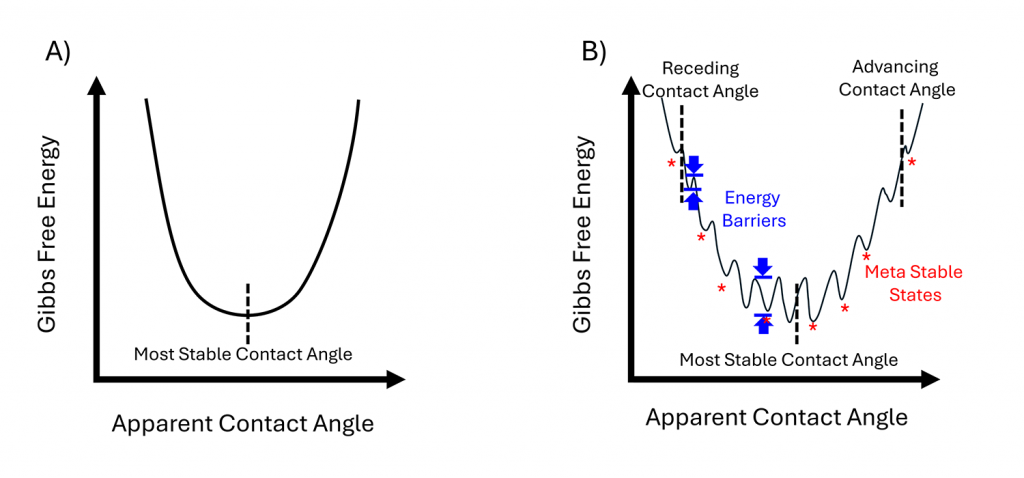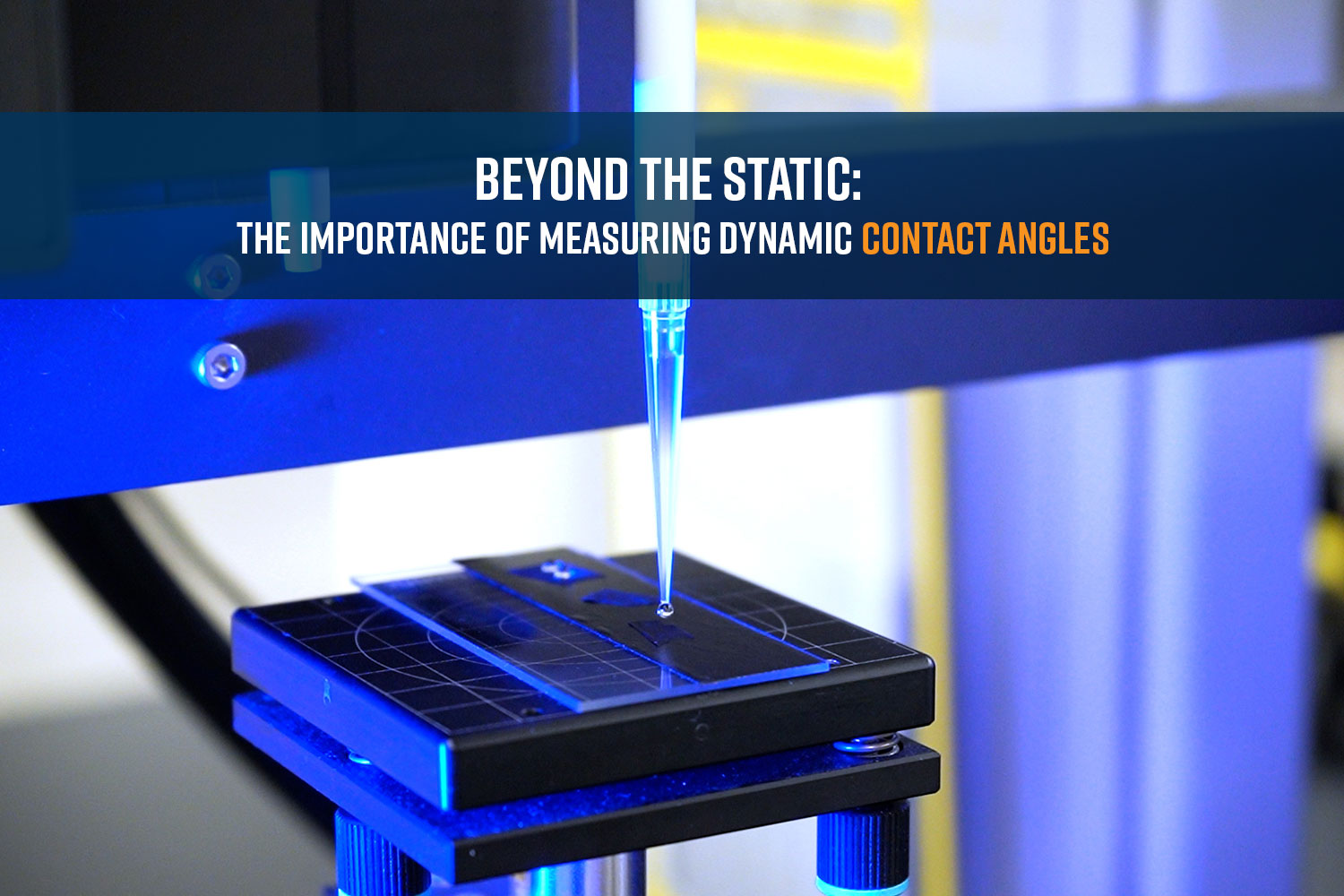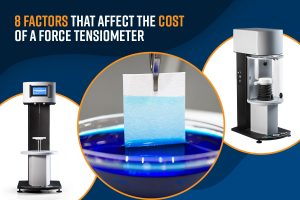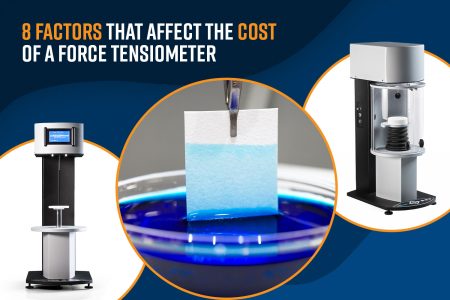When exploring the wettability of a surface, the most used technique is measuring the liquid contact angle. This has been true for >200 years, since the relationship between liquid and solid surface tension was made apparent with Young’s equation. The Young’s equation (Figure 1) defines the angle that forms on the edges of a droplet placed on an ideal solid surface (non-reactive, smooth, chemically homogenous, and insoluble) as a function of the surface and interfacial forces at the 3-phase boundary between the solid, liquid, and vapor.

Typically, this is captured with an optical tensiometer or goniometer, where a dispenser is used to place a droplet of water on the solid surface. The video of the droplet is recorded of the ‘static’ or unmoving droplet. The image is analyzed by fitting the edges and baseline of the droplet, quantifying the wettability of the surface.

For an ideal solid surface, the static contact angle is truly represented by Young’s equation and is the most stable or equilibrium contact angle. In Figure 2A, the most stable contact angle is shown as a function of the Gibbs free energy environment on an ideal surface. The most stable contact angle is at the lowest energy of the smooth curve.

Why Dynamic Contact Angle Measurements?
Real surfaces, including silicon wafers which need to be close to perfect for processes like microchip manufacturing, have a range of static contact angles.1 This is a result of the real Gibbs Free energy landscape, shown in Figure 2B, which has multiple metastable states with local free energy minima. Within a static contact angle measurement, the energy barrier between the local minima is not trivial and can result in a range of contact angles outside of the equilibrium contact angle. This is true for any static contact angle measurements on real surfaces.
However, when we push the limits to the edge of our droplet states these energy barriers, indicated with the blue arrows in Figure 2B, become smaller and minimally impact the droplet state. These lowest and highest contact angles available can be accessed by adding forces to our droplet via dynamic contact angle (DCA) methods. Thus, DCA measurements are inherently a more reproducible way to characterize a surface’s wettability on real surfaces.
Dynamic contact angle measurements are used to capture the behavior of a liquid interface as it advances or recedes on a solid surface, providing insights that are not available from static contact angle measurements alone. Included in the dynamic measurements is the contact angle hysteresis, which is the difference between the advancing and receding contact angles. This hysteresis provides information about surface heterogeneity, roughness, and chemical inhomogeneities. Thus, dynamic contact angle measurements provide insights into surface treatments, and can capture the kinetics of wetting or de-wetting, which are important for processes like spreading, coating, and cleaning.
Needle-in Method
One of the most common DCA measurements is the needle-in method.2 In this method, a thin needle (usually 30 Gauge) is inserted into a small droplet placed on the solid surface, and the volume increased by carefully pumping in more liquid into the droplet, until the droplet’s baseline begins to move outward. This is known as the advancing contact angle (ACA) measurement and is usually followed by the receding contact angle measurement (RCA), in which the volume of the droplet is pulled back into the needle until the baseline moves inward. Besides being a more reproducible wettability characterization, ACA and RCA also can be used as a sensitive method to detect surface contamination and cleanliness.
Attension Optical Tensiometers
For both DCA measurements with the needle-in method, advanced dispensing solutions are paramount. With the needle-in DCA, it is critical to have slow, even dispensing to prevent dynamic effects from convoluting the measurement data.3 These advanced features are standard on the Attension optical tensiometer series. The all-new dispenser can accurately dispense up to 4 different liquids at volumes as low as 100 nanoliters in a fully automated fashion. The pipette tip holder, great for easy cleanup with different liquids, can easily be swapped out with the positive displacement tip. This guarantees slow, even dispensing of the liquid for DCA measurements.
Conclusion
Static contact angle measurements are a good start to characterizing a surface’s wettability, but it is the bare minimum! To uncover a surface’s real chemistry and wetting properties, going beyond single liquid sessile drop measurements is necessary. Dynamic contact angle measurements offer a comprehensive understanding of the wetting properties of surfaces under realistic conditions, revealing information about surface characteristics, interfacial interactions, and wetting kinetics that are essential for various industrial and scientific applications.
Learn more about the new dispensing solution with the Attension Theta optical tensiometers here: 2024 NanoNews: Tensiometry Edition Q2
References
- Extrand, C. W. & Kumagai, Y. An experimental study of contact angle hysteresis. J. Colloid Interface Sci. 191, 378–383 (1997). https://doi.org/10.1006/jcis.1997.4935 ↩︎
- Huhtamäki, T., Tian, X., Korhonen, J.T. et al. Surface-wetting characterization using contact-angle measurements. Nat Protoc 13, 1521–1538 (2018). https://doi.org/10.1038/s41596-018-0003-z ↩︎
- Tavana, H. & Neumann, A. W. On the question of rate-dependence of contact angles. Colloids Surf. A Physicochem. Eng. Asp. 282–283, 256–262 (2006). https://doi.org/10.1016/j.colsurfa.2006.01.001 ↩︎








